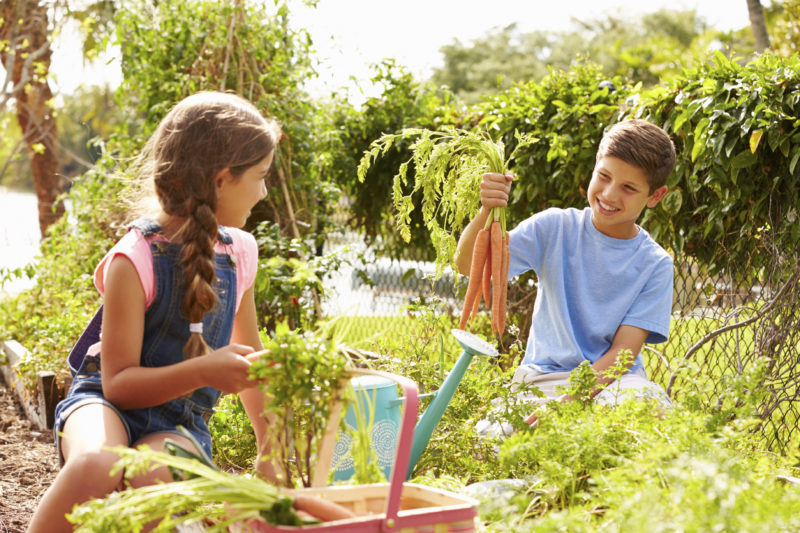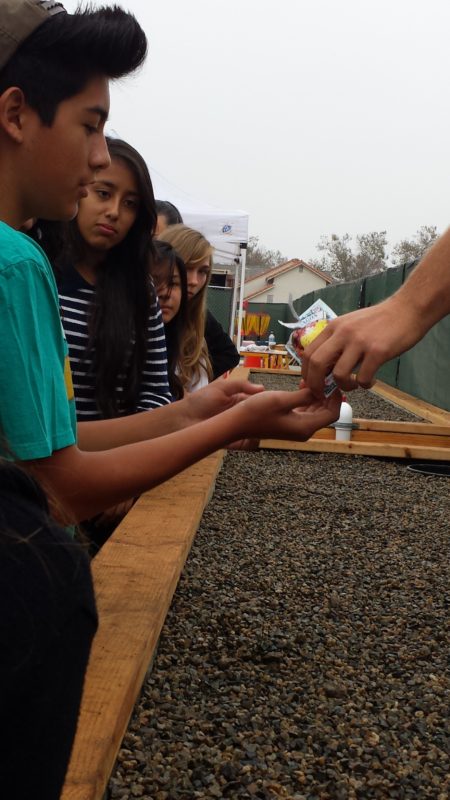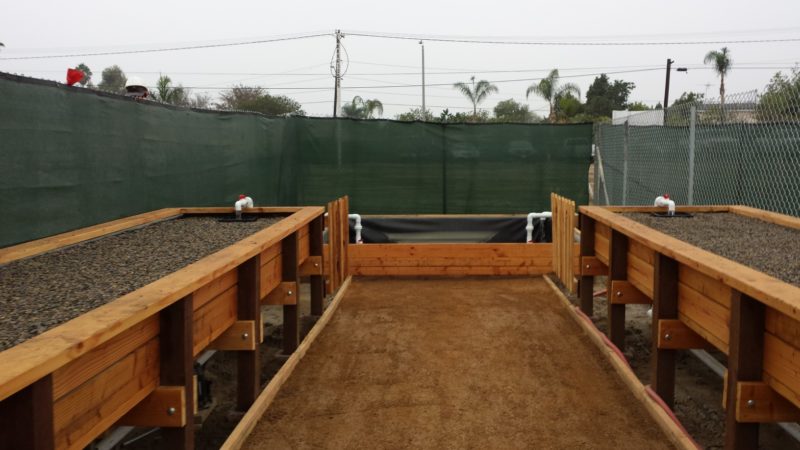Share On Social!
Latino neighborhoods tend to have less access to fresh fruits and veggies.
In Santa Ana, Calif., a high school that serves at-risk youth, offers a first-period gardening class.
It started as a campus beautification project but ended in students growing healthy, nutritious food for their community in a unique, sustainable way using fish, called “aquaponics.”
The problem of ‘spicy hot Cheetos’
 The Academy, created by California philanthropists Susan Samueli and Sandi Jackson, is a unique high school for underserved teens in Santa Ana, Calif.
The Academy, created by California philanthropists Susan Samueli and Sandi Jackson, is a unique high school for underserved teens in Santa Ana, Calif.
The school opened in 2013 to maximize individual student attention and offers work-based and project-based learning, college readiness, and new technology.
More than 80% of its students are Latino.
When it comes to students diets, Anthony Saba, the Head of School, saw room for improvement.
“Their favorite foods are those spicy hot Cheetos,” Saba said.
Because of thorough food regulations of school food by the state of California, The Academy has to provide kids with a fruit and vegetable with every lunch, many of which go untouched.
“By and large they throw them in the trash,” laments Saba.
The Academy offers a nutrition class that teaches healthy eating, but the students weren’t translating what they were learning into their daily lives, Saba said.
The school then tried an elective gardening class during first period to get students.
“Most of my students live in apartments, they don’t have gardens, they have never taken care of a plant,” said Maritza Marquez, who teaches the gardening class (and Spanish class).
Most of the 32 students in the gardening class didn’t choose the elective. Hoping to be placed into classes like photography or strength and conditioning, many of the students weren’t really sure what they might do or learn in a gardening class, Marquez said.
Initially, the garden class was focused on beautifying the campus, which lacked green spaces.
“We brought in some plants, we painted terracotta pots with crazy, fun colors and we scattered them around the school,” said Marquez.
But the class had potential to do more.
Aquaponics as a potential garden solution
 Gerald Solomon, a member of The Academy board of trustees and executive director of the Samueli Foundation—a philanthropic organization that invests in innovative, entrepreneurial, and sustainable ideas—was intrigued by an article he read about an aquaponics farm built for the local Salvation Army.
Gerald Solomon, a member of The Academy board of trustees and executive director of the Samueli Foundation—a philanthropic organization that invests in innovative, entrepreneurial, and sustainable ideas—was intrigued by an article he read about an aquaponics farm built for the local Salvation Army.
In aquaponics, plants and fish are farmed together, with the waste from the fish fertilizing the plants, while the plants purify the water for the fish, thus creating a self-sustaining cycle and a unique way to grow fresh fruits and vegetables.
Solomon wanted to learn more, so he set up a meeting with Aaron Flora, the founder of Renewable Farms and the man behind the Salvation Army project.
Flora has spent the last five to six years working to bring better nutrition to folks across the globe through sustainable agriculture, like aquaponics gardens.
Solomon was convinced that students at The Academy could not only learn valuable science lessons from building and maintaining an aquaponics garden, but that they could grow something that could benefit the health of the entire community, inside the school walls and beyond.
On the same day in mid-September 2013 that Solomon and Flora met to discuss a possible aquaponics garden at the school, Saba and some teachers were having a planning session for the upcoming school year right across the hall.
After talking with Flora, Solomon’s enthusiasm for the new project could not be contained.
“I walked into the meeting with his teachers” and asked if they would be interested in an aquaponics project at the school with funding from the Samueli Foundation, Solomon recalled.
“I said without hesitation, ‘Absolutely yes’,” said Saba.
Creating an aquaponics curriculum
Marquez was excited to add the aquaponics project into her curriculum.
 Flora, being the aquaponics expert, began going to the gardening class a few times a week to teach the kids about the aquaponics process.
Flora, being the aquaponics expert, began going to the gardening class a few times a week to teach the kids about the aquaponics process.
Marquez learned alongside the students, who “loved the idea from the beginning.”
“We did research, and we completed a couple of assignments and experiments testing levels of ammonia and nitrate,” she said.
Flora also started installing the aquaponics garden in October 2013. He brought in some of his staff as well as some community volunteers to install plant beds and a small pond for the fish. The team planned to dedicate about half of the garden area to the aquaponics farm, ensuing there was room for other gardening projects. “The ground was made of sand, so it was really easy to get through,” said Flora.
The gardening students helped, too.
“A lot of shoveling of gravel and dirt, as well as carrying it all toward our garden area,” said Marquez.
Of course, there were many decisions that had to be made during the installation process. While Saba had the unanimous support of the board and the teachers involved, he had to make sure they could feasibly put an aquaponics farm on campus.
“I made sure with the facilities guys that there wouldn’t be any hiccups,” he said.
Students also played a big role in the decision making. For example, they were the ones who decided on koi rather than tilapia as the type of fish they wanted to raise. Because the students weren’t going to eat the fish, koi was a logical choice over tilapia.
Starting the garden
Ultimately, the school saw the garden being used for a bigger purpose.
Saba says that they hope to send a majority of the fresh produce from the garden home with the students.
And the best part: “We’re not going to make our kids pay for anything,” said Saba.
They are also considering selling some of the produce to local farmers’ markets as an economics lesson, giving some away to homeless shelters, and using some of it at lunch time to feed hungry students.
The aquaponics garden—with the support of the school’s board of trustees, school teachers and other officials, and the Samueli Foundation—launched in November 2013.
By this time, Marquez’s gardening students were planting seeds for radishes, scallions, lettuce, broccoli, and peppers.
“Now we’ve got a full-running aquaponics farm that will provide fresh vegetables for students’ families,” Flora said.
In early December, goldfish were added to begin the process to incorporate the koi.
“They can’t wait to go out there every day and clean up, test the levels in the water,” Marquez said.
Once the plants are ripe, Saba says they will use the harvest to nourish the community: “A combination of giving some away, feeding our own kids, and selling a little bit of it at farmer’s markets.”
The future
Flora plans to continue teaching the kids in gardening class how to grow their own food.
“I’m going to walk them through it…make sure that they can maintain it on their own,” he said, “from feeding the fish to pulling out plants, replacing new plants, operating the system.”
Once or twice a week he comes and teaches lessons about how the farm works, including lessons on chemistry and simple gardening, topics that can be transferred into many different settings.
Ultimately, Flora hopes the students learn to prefer the fresh produce over the junky snacks they typically enjoy.
“They can look at a bag of Cheetos and say this isn’t anything like what we’re growing,” he said.
The first-period gardening class may start bright and early at 8 a.m., but the students are never late.
“They are proud of their garden and enjoy watching their plants grow…[they have] the satisfaction of caring for a living thing,” said Marquez.
“We have fun. We get dirty. We get tired. It’s wonderful!”
By The Numbers
142
Percent
Expected rise in Latino cancer cases in coming years
This success story was produced by Salud America! with support from the Robert Wood Johnson Foundation.
The stories are intended for educational and informative purposes. References to specific policymakers, individuals, schools, policies, or companies have been included solely to advance these purposes and do not constitute an endorsement, sponsorship, or recommendation. Stories are based on and told by real community members and are the opinions and views of the individuals whose stories are told. Organization and activities described were not supported by Salud America! or the Robert Wood Johnson Foundation and do not necessarily represent the views of Salud America! or the Robert Wood Johnson Foundation.



